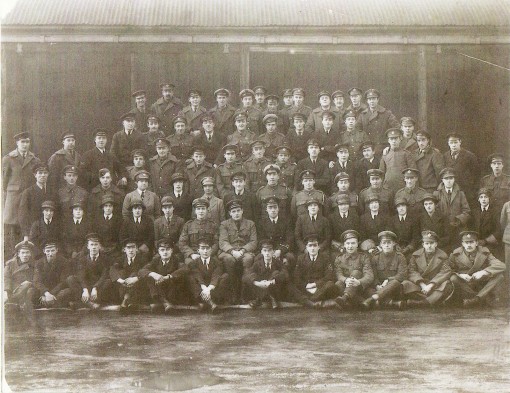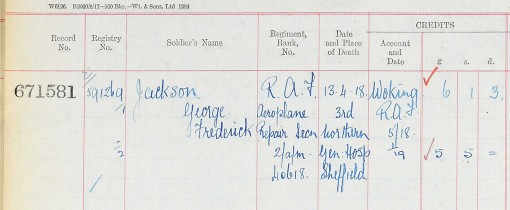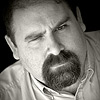
Squadron photo allegedly showing the ghost of Freddy Jackson.
I’m no scientist. I sometimes wish I were, but at the end of the day I’m merely an enthusiast who tries to use scientific methodology in my daily life whenever it is appropriate to do so. One aspect of science which I am keenly aware of is that it is self-correcting. When evidence appears which is contrary to the hypothesis one is testing, science demands that the new evidence be accounted for and that if the evidence is sound, the hypothesis must be amended or discarded.
A few months ago I shared my research on the Freddie Jackson “ghost” photo (aka Goddard’s Squadron Ghost). I have been looking into the history of this photo for some time, and with the databases I was using to search for the existence of Freddie Jackson, I did not find evidence that such a person existed. But, to my delight, a reader of that article reached out to me and he had found the very proof I had been looking for. So, to answer my own question on the matter, should we drop dead Fred? Apparently, the answer is “no.” There really was a Freddie Jackson in the RAF whose personal details parallel elements of the Goddard/Capel story.

Here is a detail of his death record. Registry number 591269 records the death of a George Frederick Jackson, who had worked in the R.A.F. Aeroplane Repair Section. He died on April 13, 1918 at the 3rd Northern General Hospital in Sheffield. When I first got this information I was curious about why the date didn’t come close to the Armistice Day (end of WWI) date that was part of Bobbie Capel and Goddard’s version of the story.
The RAF took over Lee on Solent in April of 1918. Could it be that Goddard and Capel were misremembering and that the photo was actually taken when the RAF took over in April? Perhaps this explains the variety of uniforms present—perhaps by November when the war ended the RAF uniforms would have been more unified? Here is a reminder of what Goddard said of it in the early 1970s.
Well, there he was, and no mistake, although a little fainter than the rest. Indeed he looked as though he was not altogether there; not really with the group, for he alone was capless, smiling, all the rest were serious and set and wearing service caps. Most had not long returned from Church Parade and marching in a military funeral. For Freddy Jackson had, upon that very spot—the Squadron tarmac—three days before, walked heedlessly into the whirling propeller of an aeroplane. He had been killed stone dead instantly. He, evidently, was still quite unaware of it.
— Sir Victor Goddard
So Goddard remembered that Jackson had died instantly there on the tarmac, but the death record indicates Jackson died at the hospital—in Sheffield. Geographically observant readers may already be muttering the other salient observation here: that it is a distance of over 225 miles from the base where the photo was taken to the hospital where Jackson died. He couldn’t have died simultaneously in two places so far apart.
Both Goddard and Capel recollected that Jackson died right before the squadron photo. Goddard stated that he died right where the photo was taken. Jackson was in the RAF and perhaps is the very man that Bobbie Capel knew, but the facts uncovered here seem to propel her story further into doubt.
I suspect this ghost-photo story has still got wings, and I’ll update with further developments.












Aren’t truth and reality measured by facts, not by fiction?http://www.trainingintambaram.in/web-designing-training-in-chennai.html
Finally, I have gone back to findmypast.co.uk with that service number. I have found the following extra info:
Birth year- 1891, County- Lancashire- where he is buried. Year of attestation-1916. Occupation- engineer. So, Freddy was an engineer before he worked on aircraft which probably explains why he was “First Class”.
Well, I did not stay away for long. I have searched the Commonwealth War Graves Commission website. I was wrong- he must have been buried back at home. There are ten war graves in the churchyard of St Mary, Mellor in Lancashire. Here is the detail from the website:
G F Jackson, Air Mechanic First Class, Service Number 214491
Date of death- 7th November 1918- Royal Air Force.
So, it appears that document above is not our man. Completely different service number- but this G F Jackson died just four days before the Armistice. I believe the Armistice on the 11th November was a Monday- the 10th- three days after the death as Sir Victor tells us in the book was the Sunday- Church Parade and a military funeral in the base church/chapel. So, it looks like Freddy Jackson once was a real live air mechanic- first class, no less. Is that really him in the photo?
Well, I’m back with some further observations. The document shown is not an official death certificate- I don’t know what it is- it shows a couple of figures of money- £ s d. It also appears to mention RAF Woking and a date of 5/18. I was once told that the RNAS or RFC had a base near Old Woking but I can find no evidence for this in a quick search- I’m sure an airbase would yield results on Google.
With regard to his place of death- he walked into a propeller- goodbye in any language. Was his body taken by a military ambulance to Sheffield to a large hospital with a big mortuary to tidy him up? If that’s where “life extinct” was declared then for official purposes, that’s where he died. Goddard tells us he died on the tarmac at Cranwell and the squadron in the photo had been on Church Parade and “marching in a military funeral” – presumably, Jackson’s funeral and this photo took place three days after his death. Had the body been shipped 70 odd miles to Sheffield then back in only three days? It is worth mentioning that military men were dying of their injuries in considerable numbers at that time in hospitals all over the country. Furthermore, if the date is November 1918- as Goddard states and all the anecdotal evidence suggests it- then the Flu Pandemic was killing people on a huge scale, as well. I am afraid that death was no stranger- so perhaps there was a kind of production line method of dealing with these unfortunate victims- then he could have been brought back in that time.
If Freddy Jackson (spelled “Freddie” in the index for some strange reason) had his funeral at Cranwell was the body buried near the base- or was it- which is most most unlikely shipped home? This would probably cost the relatives money so Is he buried at or near Cranwell on that basis?
I have spent a little time on the internet and it appears there were nearly 20 “F Jackson” names in the Royal Flying Corps and indeed one G F Jackson. On the list, most of them have their names spelled out- not G F Jackson himself. If you go to the National Archives and look up RAF personnel 1918-39 you can find George Frederick Jackson if you then click to go to the search provided by Find My Past-which is a commercial site. You can see the same service number-40618 as you see on the document above. A little oddly, there is no more detail whereas the other records show some- if not all of the following-birth year, birth county, attestation year, his previous occupation but nothing for George Frederick Jackson.
I decided to do a similar search for Robert Victor Goddard- Goddard’s full name- but he did not show up! There is a Victor Edward Goddard- not Robert Victor Goddard. The National Archives state that someone like Sir Victor that was in the Royal Navy- transferred to the RNAS and then into the new RAF in April 1918 would have a service number between 313001 and 316000 but I can’t find him!
I have not paid to use this service in more depth. So there were plenty of F Jacksons in the RFC it seems. Was the one that died above the man that Sir Victor mentions- or is there another? It seems it might be easier to find Freddy Jackson through the online archive search facilities than Sir Victor, himself!
I reckon that’s me done on this. I have a cousin that is paid up with these sites and does research like this- perhaps, he can take a look for more information.
One final comment and this may be a flight of fancy. The date in the registry shows 13/4/18. To my eye that 4 could be construed as an 11. However, elsewhere we can see another 4 that is very similar. This registry entry will have been made with details from elsewhere. Has the clerk seen the date 13/11/18- two days after the Armistice- but written somewhat carelessly and it has been interpreted as a 4? This is a long shot but it is plausible as Goddard is adamant about the reason and approximate date behind the photo and Jackson’s death- the end of the War- 11/11/18. In early April 1918 the Germans were on their massive Spring Offensive sweeping all before them-all squadrons available would be in France- not posing for photos in Lincolnshire.
I made a number of typos and errors in my above post- I referred at one point to the Royal Naval “Flying” Service- when that should have read “Air”. I missed out the word “One” after World War when I go on to mention how the Royal Navy invented the aircraft carrier and started a whole new era in naval aviation- sea based and established its own new air bases on land-the Royal Naval Air Stations- one of which was HMS Daedalus at Lee-on-Solent.
Indeed, one of my school friends- his father worked for the Admiralty at Daedalus and as I mentioned in the above post it was not far away. I also mentioned it was a “red herring” and this quote from Wiki will show why. It is from the history of RAF Cranwell where Victor Goddard states clearly that Freddy Jackson died after the Armistice a couple of days before this photo- taken especially to commemorate the disbanding of the squadron took place. Here is the quote:
The history of military aviation at Cranwell goes back to November 1915,[1] when the Admiralty requisitioned 2500 acres (10 km²) of land from the Earl of Bristol’s estate.[1] And on 1 April 1916, the Royal Naval Air Service, Training Establishment, Cranwell was officially born.[1] The first commander was Commodore Godfrey M. Paine.
As the naval personnel were held on the books of HMS Daedalus, a hulk that was moored on the River Medway, this gave rise to a misconception that Cranwell was first established as HMS Daedalus.[2]
The River Medway is in Kent-joining the Thames Estuary- nowhere near Lee-on-Solent. There were many hulks in that area. So, this eliminates Lee-on-Solent for good from this analysis.
Victor Goddard, himself stayed in the RAF- he had joined the Royal Navy at 14 in 1910 and transferred to its new air arm- the RNAS becoming part of the RAF in 1918 and staying in the service until 1951- so he went from dirigibles to jet aircraft in his time.
This is also from Wiki:
In 1921 Goddard was selected to read engineering at Jesus College, Cambridge and then studied at Imperial College London before returning to Cambridge in 1925 as an instructor to the university’s air squadron. After graduating from the Royal Naval Staff College in 1929….
It is interesting to note that he appears to have gone to the Royal Navy Staff College- not the RAF College at Cranwell. Goddard was an engineer as well as aviator.
As uniforms appear to have been given undue precedence in this quest for the reality to the photo on an anecdotal level I will conclude by mentioning that Frank Muir, a famous British comedy writer and TV personality was sent to Iceland in World War 2 with the RAF. In his autobiography “A Kentish Lad” he mentions that the commanding officer of the air base he was stationed at still wore his Royal Flying Corps khaki tunic- not an RAF blue/grey tunic and this was nearly 25 years after the RAF was founded! Finally, with regard to this sort of photograph and logical explanations for strange images, I am no expert. However, I was in a school photo like this that included 600 odd people. I had to kneel near the front and we were told not to move as the camera panned across us. As the camera pointed my way, I was given a sharp kick by a boy seated behind me and I moved. As a consequence I was depicted as a blur- so I never bought the photo as it was nothing to have any pride in.
Anyway, this photo is indeed still a mystery but the focus should be on Cranwell- were accidents there logged and indeed investigated? I am sure they must have been- but were the records destroyed by bombing in 1940. All the anecdotal evidence tells us it was late 1918 or early 1919- certainly after the Armistice. This new evidence is intriguing.
.
The photo was taken at Cranwell, Lincolnshire according to Goddard as the squadron was about to be disbanded and Cranwell is 67 miles from Sheffield by road.
You keep focusing on HMS Daedalus which was far away on the south coast of England in Hampshire and I think this is not relevant. In your earlier post you showed that you were somewhat confused. The Royal Naval Air Service (RNAS) and Royal Flying Corps (RFC)- the Navy’s and the Army’s own air forces were combined into a new independent service -the Royal Air Force (RAF) in April 1918.
The RAF later adopted a new uniform of blue-grey- you are now mentioning uniforms in your analysis. However, for a long while, the men that served in the new RAF carried on wearing their old uniforms and used their old naval or army ranks. A new rank structure that incorporated the ranks of the Navy and the Army was devised- ranks like Group Captain, Wing Commander, Squadron Leader etc were devised and the various insignia of the two were adapted for the new RAF. As for this new uniform and its colour, there is a strong possibility that in Britain in 1918, there was a mass of uniform material that had been made for the Imperial Russian Army and because of the Revolution there this was now stuck in Britain and this needed to be used. On that basis, it was chosen as the new material/colour for the Royal Air Force because it was immediately available and needed to be used.
You have mentioned in your earlier post that HMS Daedalus was both RAF and then RNAS over the years. This is spurious and is based on your misunderstanding because the Royal Navy had after World War new air force for use on the carriers it had invented- called the Fleet Air Arm-which for many years was under the aegis of the new RAF but was brought back under Navy control for WW2. It’s bases were termed- and still are- Royal Naval Air Stations- which is why the letters RNAS continue to figure long after the 1918 amalgamation of the original RNAS and RFC to from the RAF.
I know this is all tedious stuff but you need to get on top of these basic facts. Another important fact is that German bombing in 1940 destroyed 60% of Army records from World War One. I do not know if “Freddy Jackson” was in the Army- that is the Royal Flying Corps- or the Royal Navy- that is the Royal Naval Flying Service and if these records were replaced with new Royal Air Force documents and whether these suffered due to the 1940 bombings.
Goddard is adamant that the photo was taken because the War was over and the squadron was being disbanded- he writes about “Civvy Street” quite clearly. Yes, his memory may not have served him well- we do not know. However, I think the idea was that members of the squadron could purchase the photo from Bassano as it was the end and this was their memento of their time in the war as aviators and ground crew etc.
To conclude, you keep focusing on Lee-on-Solent which as you write is 225 miles from Sheffield but Goddard tells you that the photo was taken in Cranwell- 67 miles from Sheffield. This may or may not be the right “Jackson” but you seem to be rather fixated with your continued focus on HMS Daedalus and it’s various incarnations since 1918 which are completely irrelevant to the story based on the supposed facts- it is Cranwell in Lincolnshire where Jackson is supposed to have walked into the propeller.
Finally, in passing, I lived a few miles from HMS Daedalus as a teenager and I watched their training jets come screaming over my house- Fleet Air Arm naval jet fighters from Royal Naval Air Station, Lee-on-Solent- hundreds a miles from Cranwell and nothing to do with the facts as Goddard presents them. It may or may not be a photo of a ghost but much of what you have written about has no relevance to the veracity of this story at all.
The image of the photograph that you have presented, both in this and your previous article, has exceedingly poor image quality because it was scanned using a low quality scanner that was inappropriately adjusted for the image being scanned. The high levels of scanner noise and banding artefacts provide, I think, more than sufficient evidence of my assertion.
In your previous article dated 2015-02-02 you stated “At the top of this post is a nearly uncropped scan of the photo in question. In the back row, if you look closely at the fourth sailor from the left, you’ll see that behind his head is a ghostly face.”
No! If you look closely you will see a smudge that is impossible to recognise or otherwise draw any conclusions from. It is physically impossible from that image to produce a ghostly face of Freddy Jackson, a dog, or Bigfoot. Only a person who has a very high level of confirmation bias could use imaging software to turn that smudge into a human face having at least an order of magnitude more resolution and lower noise than the scanned image that you have twice presented.
I need to see independently verifiable images of the original photo, produced using high quality imaging microscopes and other imaging techniques; until such time I shall rely on the epistemological razor: “What can be asserted without evidence can be dismissed without evidence.”
Quite so. If that overall photo is the best scan there is, then there is no way you can enlarge like that. Details actually improve after enlargement, which is not possible of course. Also, the face of the man in front has changed in expression somewhat. There is evidence of fraud.